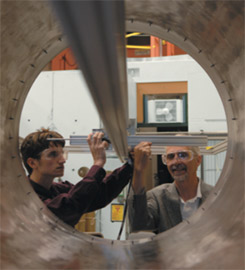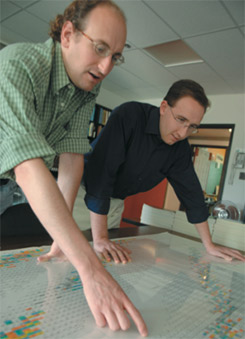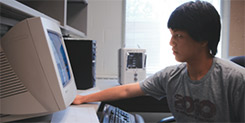In Fermi’s Footsteps
Last summer, three University of Chicago undergraduates explored some of science’s most pressing questions as interns at Argonne National Laboratory. By Michelle Caswell. Photographs by Dan Dry
Long before Enrico Fermi became a Nobel laureate, he was an undergraduate student working on X-ray diffraction in his adviser’s lab. Last summer, three Chicago undergraduates followed in the physicist’s footsteps by teaming up with researchers to explore some big questions in the sciences as interns at Argonne National Laboratory. Argonne, which Fermi founded, is one of the nation’s leading centers for federally funded scientific research and is managed by the University of Chicago. The lab’s ten-week, paid summer internship program is funded by the University’s vice president for research and national laboratories. The program gives students hands-on experience working on scientific research at the cutting edge in a laboratory of national stature. For their part, the scientists who work with them get to add a bright young mind to their labs.
“It is good for College students to see ‘real world’ research as early as possible,” says John Frederick, master of the Physical Sciences Collegiate Division. “As for the scientists at Argonne, any large research project spins off a series of sub-questions that need to be answered. These smaller sub-projects are ideal for a student to work on during the summer. If the student makes good progress, the Argonne-based researcher obtains useful results.”
One student who made good progress last summer was junior Zach Grelewicz, an intern in physicist Birger Back’s lab. Grelewicz was trying to recreate the conditions inside stars and supernovae. By accelerating heavy nuclei in a spectrometer, Back and his team of researchers plan to observe the properties of unstable nuclei and, ultimately, push the forefront of low energy nuclear physics. “Studying how nuclei behave when they are unstable is important for understanding many of the processes that go on in stars and supernovae,” says Back. “These processes create all of the elements that we are made out of and everything that we see around us.”
Grelewicz created simulations of how forwardfacing silicon detectors within the spectrometer should be designed in order to maximize identification of particles and reactions. “Most research in physics is far beyond a level that undergraduates can tackle,” he says. “But the principles involved in this project, such as particle identification using a spectrometer, are straight out of the undergraduate curriculum. It’s great to work on a project where all the concepts are not over my head.” While this was Grelewicz’s first professional lab experience, the physics and math double major sees plenty of overlap between his courses at the College and his internship. “At Argonne, I apply a lot of the physical intuition I picked up in my classes,” he says. “When you are looking at data in the lab and you see something that doesn’t match the trend, you think back to what you learned in physics class and apply the basic principles to figure out why the data doesn’t match the theoretical conditions.”
His boundless sense of curiosity, coupled with hard work, is driving Grelewicz to make a small but significant impact on Back’s experiments. “Zach has absolutely contributed to my larger project,” says Back. “The simulations that he is running are very important for the success of the spectrometer and promise to be very useful for studying reactions in the future.”
Another Chicago student who made his mark at Argonne this summer is senior Brent Graner, who interned with physicist Kenneth Nollett in the nuclear theory group. Like Grelewicz’s project, Graner’s work involved reaching a better understanding of the ways in which nuclei behave. Instead of using a large instrument like a spectrometer to observe particles, however, Graner is using a computer program to simulate nuclear wave functions and describe the shape of nuclei. His ultimate goal is to make computer visualizations of the three-dimensional distributions of particles inside a nucleus. Such visualizations could help scientists gain a better understanding of the way nuclei work, and could become important teaching tools.
“By using data produced by an existing computer code to create pictures of nuclei, I hope to get some interesting and informative images that are accessible to people outside of science,” says Graner. “These images could even help diagnose places where the theory could be improved.”
Nollett echoes Graner’s optimism about the project. “Brent is learning how to make interesting and informative three-dimensional images of nuclei out of the results of our calculations,” he says. “In the end, we should have both a useful set of tools for understanding our own calculations and some nice, visually compelling images that we can use to promote our work both within and outside the nuclear physics community.”
Nollett thinks Graner is making an important contribution to his lab. “For a long time, I’ve been saying that better visualizations of our nuclear models would be both useful and good for promoting our work,” he says. “However, before Brent started, no one in the collaboration has had a compelling reason to sit down and invest time into developing them.” He adds, “This is a good project for an undergraduate because he doesn’t have to know all the details of our fairly complicated computer models in order to do useful work, and he can learn some interesting science in the course of helping us.”
For Graner, a physics major, working at a worldrenowned lab has been an invaluable learning experience. “Interning at Argonne has certainly challenged my understanding of computer science and pushed me to put all of the knowledge I acquired in computational physics and computer sciences courses to work,” he says. “It has also required everything that I have learned in physics thus far to grasp the concepts and the quantum dynamics behind all the theory that is embedded in the computer code I’m using in the lab.”
Graner sees his work at Argonne as an integral part of his Chicago experience. “Getting involved with research is a very important part of an undergraduate degree in physics,” says Graner. “To be able to partake in research on a national level and to learn how physics is done professionally has made a big impact on my education.”
Similarly, College sophomore Michael Zhu put the computer science he learned at Chicago to use this summer as an intern in Argonne’s environmental science division. Working closely with researcher Rao Kotamarthi under the supervision of Michael Stein, the Ralph and Mary Otis Isham Professor in the Department of Statistics and the College, Zhu helped scientists better track global warming patterns by using statistics to build a spatial model of the flow of carbon dioxide in and out of the earth. Ultimately, Zhu’s work could help give scientists a more precise picture of the carbon budget of the earth, thereby resolving some scientific uncertainties related to global climate change and creating an accurate model of global warming.
“It’s easy to measure the carbon dioxide in the atmosphere and in the ocean, but it’s much harder to measure it in the land, because there are so many different types of terrain and there’s no simple way of figuring out how much there is,” explains Zhu. “My work builds on data collected by an international project called AmeriFlux that measures the carbon dioxide going in and out of the earth at specific sites. The idea is that by measuring these specific sites, you may be able to get a big picture of carbon dioxide flow specifically, and global warming in general.”
Like Grelewicz and Graner, Zhu’s internship has drawn heavily on his Chicago coursework. “If I didn’t know the statistics I learned in class, I would be lost here at Argonne,” he says. “The rigor of the Chicago curriculum and the theory I learned have been invaluable this summer.”
Zhu’s advisor at Argonne thinks he could make a lasting contribution to environmental science. “Equipped with his coursework in statistical methods, Michael is in a position to develop a first set of models for our efforts to develop a preliminary evaluation of carbon flux data sets from about 70 different sites located across North America,” says Kotamarthi. “We hope to use the statistical models he generates to develop carbon flux maps. Michael’s efforts are laying the groundwork for developing these statistical models and eventually the development of evaluation data sets for the carbon cycle models.”
For all three of last summer’s Argonne interns, the work they did there will likely have implications for their long-term career plans. “Unlike work in class-related laboratories, the answers to questions that are investigated in professional labs are not known in advance,” says PSCD Master Frederick. “Probably the hardest part of research involves defining the right questions to ask and how to pose a problem in a way that can lead to useful answers. Students who have encountered these issues in the context of creative research are ahead of the pack when they apply to graduate schools or enter the workforce.”
While Graner is still deciding between a career in physics, finance, or patent law, he is certain that his experience at Argonne will help him reach his goals. “This internship is going to be a big bonus for me if I pursue anything related to technology,” he says. “To be a part of an intensive project like this that puts my computer knowledge to work on this kind of scale is going to give me an advantage in any field.”
Grelewicz, who plans to pursue a doctorate in physics, agrees. “I think this internship has been absolutely necessary,” he says. “To be a career researcher, you have to go to graduate school, and having research experience is immeasurably helpful in getting into graduate school. This internship is an important first step.”


